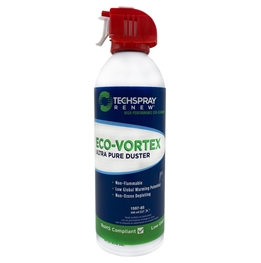- HFC-134a: Nonflammable, most common for industrial applications when spraying energized circuits because of the risk of a spark lighting a flammable material. It is under close scrutiny because it has a Global Warming Potential (GWP) of 1400, so 1400 times the impact of CO2. On the back label, look for “1,1,1,2-Tetrafluoroethane” or CAS #811-97-2
- HFC-152a: Most commonly available duster in consumer retail because it is less expensive than HFC-134a. It is flammable, and will ignite when concentrated (i.e. in liquid form) and exposed to a spark or flame. HFC-152a has the advantage of a lower GWP (130) than HFC-134a. On the back label, look for “1,1-difluoroethane” or CAS #75-37-6
- HFO-1234ze: This is a newer, nonflammable material introduced in the last 10-years as a very low GWP alternative (<1) to HFC-134a. It is non-flammable and is almost indistinguishable from HFC-134a when sprayed, but unfortunately at a much higher price. On the back label, look for “trans- 1,3,3,3-Tetrafluoropropene” or CAS #29118-24-9
- CO2: It's as not as common because the spray force is not consistent. Because of the higher pressure, it comes in small, low capacity cartridges. The spray force diminishes as the cartridge is empty. On the back label, look for “carbon dioxide” or CAS #124-38-9
- DME: DME is rarely used and in many areas cannot be legally used because of safety and environmental concerns. DME is extremely flammable and is a VOC (volatile organic compound), which can contribute to smog. All of the other duster alternatives do not contain VOCs. On the back label, look for “Dimethyl ether” or CAS #115-10-6
-
Retail duster generally contains HFC-152a – Look on the back of a can of aerosol hairspray, and you’ll generally find propane (the same propane as in your gas grill) or butane (the same butane in a Bic lighter). These chemicals are used because they are cheap, not because they are safe. In industrial markets, safety is a top concern, with careful oversight by OSHA (in the US specifically). Because of this, HFC-134a is more widely accepted in industrial markets, even at a higher price.
-
Purity can be questionable – Industrial buyers rely on trusted industrial brands because the quality is closely controlled. The material is highly filtered and controls are in place to avoid moisture and other contamination.
-
Additives to prevent huffing – Many retail dusters have bitterant added to prevent huffing. When duster is used in the home, there is concern that the material will be purposely inhaled (called “huffing” or “dusting”) by minors, which can sometimes lead to tragic consequences. To avoid this, bitterant is added to make the duster taste bad. This same bitterant can lead to unwanted and potentially harmful residues on sensitive surfaces like electronic circuit boards.
-
Check fill weight – Retail duster can come in a variety of fill weights (the content of the material in a can) including 3.5 oz., 8 oz., 10 oz. and larger. This can only be judged by the label since the size of the spray can may not vary.
Duster Doesn't Hurt The Ozone Layer
-
High spray force: Each type of Techspray has a potential to produce a certain amount of force. HFC-134a has the greatest potential, HFC-152a next, and HFO-1234ze a distant third. In approximate terms, the HFC-152a has about 10% less potential to generate force compared to HFC-134a, and the HFO-1234ze has about 33% less potential to generate force compared to HFC-134a. Techspray offers duster products with even higher spray force by controlling output through valving and sprayer.
- Invertible: Because of how the valving of aerosol dusters are designed, they generally can only be sprayed right-side-up or, at most, a 45º angle. Under high pressure, the propellant is mostly liquid, with the empty part of the call filled with vapor. When you spray an aerosol duster, the vapors of the propellant are expelled. As you rotate the can, the liquid starts to spray out and at a very low temperature (as low as -60ºF / -51.5ºC). It is a bad idea to shake up a can of duster before use, as is the habit of using spray paint. If you shake duster, the liquid propellant will more likely sputter out as you start spraying.
-
Chrome trigger/refill cans: Some dusters includes a chrome trigger sprayer and a refill can with a threaded valve. This allows you to reuse the sprayer and purchase refill cans. The advantage of the chrome sprayer is more precise control over spray force and ESD (electrostatic discharge) control. The standard plastic sprayer has the potential of building up a static charge as you spray. The chrome trigger is conductive, so will not build up a charge, and has the potential of being grounded. For example, if the user is grounded by a wrist strap, the sprayer and can be grounded as well if in good contact with the person’s hand.
- Shop air: In an industrial setting, dropping an airline is very common. In this case, a compressor constantly keeps the line pressurized with air. It can be an economical way to blow off dust, dirt and other contaminants, but you are tethered by the airline. This gets to be impractical for field work or in-house work that requires more flexibility. In addition, contamination can be brought through the airline from ambient air or oil from the compressor.
- Mechanical dusters: Plug-in or battery operator dusters are available. They can offer savings compared to aerosol dusters, which must be replaced after each can is spent. The actual spray force can be as low as 60-70% less than an aerosol duster, and they can be as loud as 90 kB (similar to the volume of a lawnmower)
- Bulb dusters: Photographers will be familiar with the bulb type blowers that are often used for lens cleaning. These may be an economical solution for very light dust, but the force generated in a small fraction of aerosol duster.




